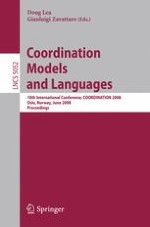Modern information systems rely increasingly on combining concurrent, d- tributed, real-time, recon?gurable and heterogeneous components. New models, architectures, languages, and veri?cation techniques are necessary to cope with thecomplexityinducedbythedemandsoftoday’ssoftwaredevelopment. COOR- DINATIONaimstoexplorethespectrumoflanguages,middleware,services,and algorithms that separate behavior from interaction, therefore increasing mo- larity, simplifying reasoning, and ultimately enhancing software development. This volume contains the proceedings of the 10th International Conference on Coordination Models and Languages, COORDINATION 2008, held in Oslo, Norway in June 2008, as part of the federated DisCoTec conference. COORDI- NATIONitselfispartofaserieswhoseproceedingshavebeenpublishedinLNCS volumes 1061, 1282, 1594, 1906, 2315, 2949, 3454, 4038, and 4467. From the 61 submissions received from around the world, the Program Committee selected 21 papers for presentation and publication in this volume on the basis of or- inality, quality, and relevance to the topics of the conference. Each submission received at least three reviews. As with previous editions, the paper submission and selection processes were managed entirely electronically. This was acc- plished using EasyChair, a free Web-based conference management system. In addition to the technical paper presentations, COORDINATION 2008 hosted an invited presentation by Matt Welsh from Harvard University. We are grateful to all the Program Committee members who devoted much e?ort and time to read and discuss the papers. Moreover, we acknowledge the help of additional external reviewers who evaluated submissions in their area of expertise. Finally,wewouldliketothanktheauthorsofallthesubmittedpapersandthe conferenceattendees, for keeping this researchcommunity lively and interactive, and ultimately ensuring the success of this conference series.
